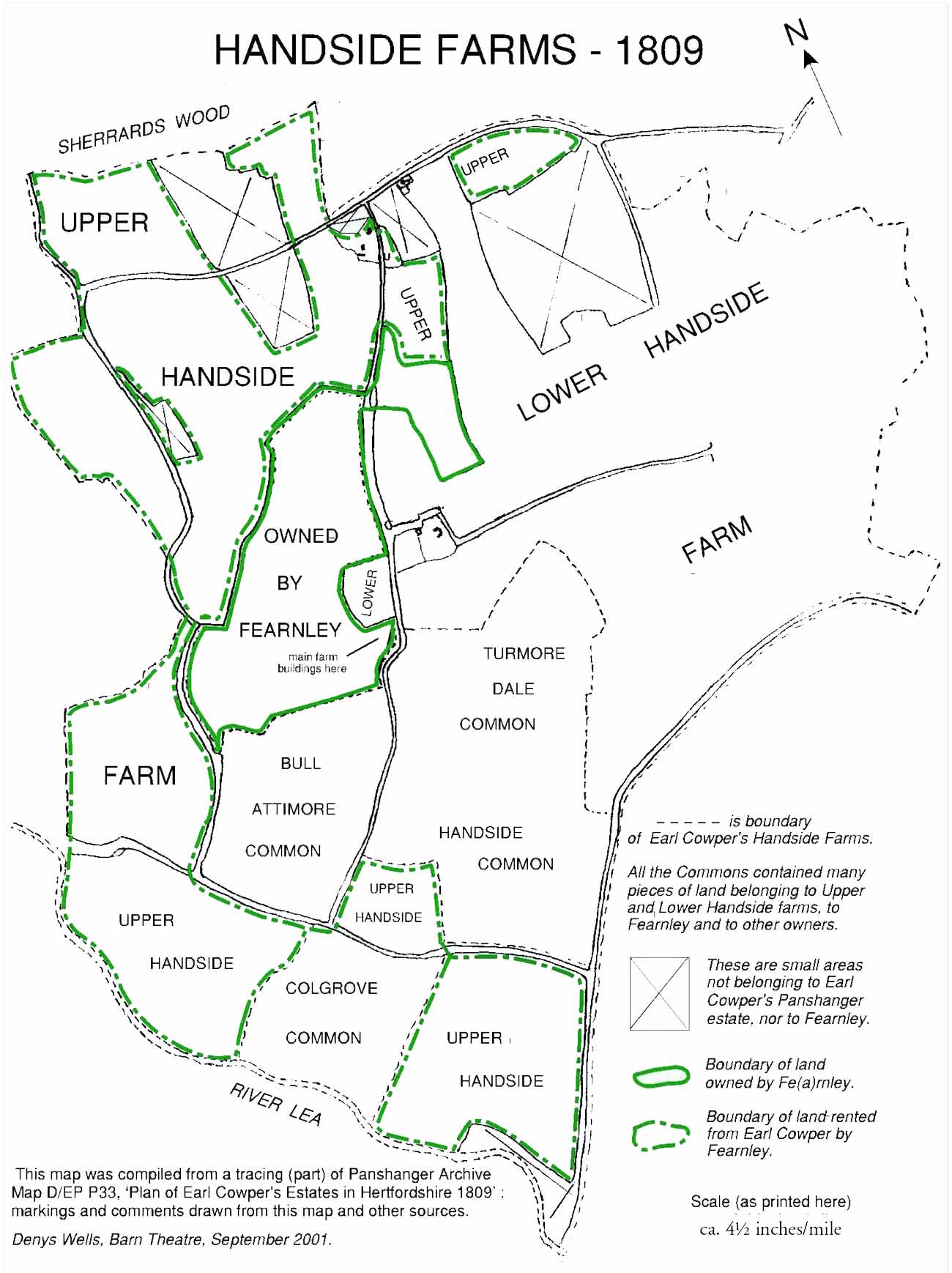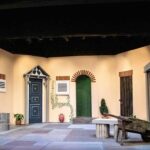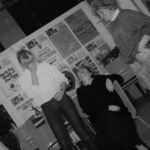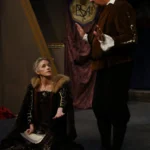The Handside Barn
Agricultural uses 1830 – 1940
A summary by Denys & Marion Wells, Barn Theatre Archivists for many years.
The occasion of recent Heritage Open Days, when the building itself, rather than its present occupants, was the centre of attention, gave us the opportunity to summarise what we know about the origins and uses of the great Barn at Handside, Welwyn Garden City. Many writers have given accounts of the history of the area, but even those who have written about the Handside Barn in detail have dealt mostly with the later period, after the foundation of Welwyn Garden City in 1919/20. We also include here a summary of the later years, but most of the new information we now have concerns the origin and uses of the building over its first century or so.
For the earlier period we have relied mainly on two primary sources of information, the archives of the Panshanger estate, which for at least a century owned the land on which the Barn stands, and the reminiscences and history of the Horn family, who farmed the area as tenants for some ninety years. Claire Calvete, a local student, in 1978 studied the Panshanger Estate Archives (Ref. 1) for part of her degree thesis (Ref. 2), a copy of which she kindly gave to the Barn Theatre. We have used some of her findings about the Handside Barn, and supplemented them with our own research in these archives, and with 19th century census details. There are no longer any members of the Horn family in this area, but past accounts given by some of them have been widely reported (Refs. 2,5,6): also James Horn, a descendant of the Handside family, now living in Australia, has given us more information about their family history (Ref. 4), both by correspondence and in person during his visit to Welwyn Garden City in June 2011.
Farming at Handside
The Handside farm area is roughly that between [using modem names] Bridge Road in the north, the River Lea in the south, Stanborough Lane in the southeast, and a lane through Dognell Green in the west. Between the latter lane and the (Great) North Road was Brickwall farm. Ownership of land, by individuals who had inherited land from early yeoman farmers, or by the estates of Hatfield, Panshanger and Brocket, was constantly changing in the early part of the 19th century, and it was as a result of these changes that the great barn came to be built on its present site. Though the detailed picture is complex and still incomplete, we can now broadly explain what happened, when, and why.
Upper and Lower Handside Farms
The names ‘Upper’ and ‘Lower’ were not always used consistently, but in general can be taken to refer to lands on the west and east sides respectively of Handside Lane. In 1799, Land Tax papers gave the occupiers as Edmund Fearnley at Upper, and Mrs Perkins at Lower Handside, each having about 240 acres: we know nothing of Mrs Perkins, but the Fearnley family were key to what happened some 30 years later. William Battell of Handside (from a family said to have farmed at Stanborough since 1468) had died in about 1723, and in 1786 some or all of his land (part freehold, part copyhold from the Manor of Hatfield) passed to his great-great-granddaughter Sarah, who had recently married her second husband, Edmund Fearnley, a farmer from Hatfield. We do not know exactly how much land Sarah inherited, but the Fearnleys owned and occupied a large area of Upper Handside in 1809, when the earliest Panshanger estate map was made: the estate records show that they also rented 233 acres of Upper Handside from Panshanger. Lower Handside (212 acres) was rented from Panshanger, and farmed, by Thomas Ephgrave.
The 1809 map shows the Handside area with a complex distribution of fields between the two farmers, plus some fields occupied by others: much of the area from about Applecroft Road/Attimore Road down to the River Lea was commonland, fanned by strip cultivation, with various occupiers intermingled (in 1723 the Battell land included some 64 acres of commonland, divided into 146 pieces!). The original 1809 map and survey did not record any barn at Lower Handside, but a barn and farmhouse had later been pencilled in on the map, to scale, on their present site.
The estate records show that Sarah Fearnley over the farm from her husband after his death in 1810, until her own death in 1828, after which both the Panshanger farms, Upper and Lower, were in the rent accounts as ’empty’. They continued empty until 1832, when Thomas Horn was shown as the tenant of a single Handside farm. From 1828 the Fearnleys’ son, also Edmund (who changed the family name to Feamley-Whittingstall) was actively rationalising his inherited land, by buying the freehold of his Hatfield copyhold land, and then exchanging fields, particularly those in the commonland, with the Panshanger estate. This Edmond was a businessman in Watford, not a farmer, so he rented his reorganised Upper Handside to a tenant farmer (the 1839 Tithe Apportionment survey records Henry Cox, probably Edmund’s cousin, as occupier of about 130 acres).
A second Panshanger estate map of 1833, as well as the 1839 Tithe map, shows the result of these land exchanges, including some (with the Hatfield and Brocket estates) at the margins of Handside, to tidy up the boundaries. The great barn, and a new farmhouse, are in place on their present sites, as the main house and barn of the unified Panshanger Handside farm.
All this confirms that the barn was erected on its present site in or about 1830. Claire Calvete (Ref. 2) found supporting evidence for this in the estate accounts for this period, with a very large bill for building work at Handside farm, the biggest single item being carpentry. As the new farmhouse was not a timber building, it is a reasonable assumption that most of the carpenters’ work was on building the timber barn, certainly a very big undertaking: they clearly made a good job of it, as it is still going strong 170 years later.
Origin of the Handside Barn
It is commonly stated (probably from information passed down through the Horn family) that the present barn in Handside Lane was originally built closer to Handside hamlet, possibly in the late 1600’s. Claire Calvete’s suggestion (Ref. 2), based on smaller-scale maps of 1810, that it had been the Upper Handside barn listed in the 1809 survey, now seems unlikely. It is obvious from the larger-scale 1809 map, where individual buildings were shown to scale, that the new barn, over 200 feet (60 metres) in length, was enormous in comparison with other buildings in the area – it seems to be bigger than the three Upper Handside buildings combined (all of which were anyway still in place on the 1833 map).
We respect the tradition that a 17th century barn was moved to Lower Handside from somewhere in the immediate area, but we still have no firm evidence to confirm this. It is possible that an old barn had previously been taken down and stored for future use, or it might have come from non-estate land in the area, so would not have been shown on the 1809 map. Another possibility is that the present building, with a distinct change in roof angle about halfway along the main structure, may be the result of combining two smaller barns. It is unlikely that a totally, or even partially, new structure would have been erected with this step in the roof, so maybe we should be looking for two previous sites, not one! Our searches of the Panshanger archive have not found anything relevant to this, so it is likely that we may never know the age or origin of the barn(s).
Handside Farm – the next 90 years
According to the Horn family history (Ref. 4), Thomas Horn (1771 — 1846) was a farmer from Bramfield, though his family were from Bedfordshire. He married Anne Cooper in 1797, and their son William Cooper Horn, born in 1810, moved to Handside in about 1830. William died at an early age in 1838, when his widow Mary Ann became tenant: their son William James Horn had been born in 1837.
Census records for 1841 show the farmer as Mary Horne, age 25, living with her son James, age 3, and her mother Anne Woodhouse. By 1851 Mary Ann Horn was head of a farm of 280 acres, with 13 labourers.
Edmund Fearnley-Whittingstall sold his Handside farm to the Panshanger estate in about 1858, and in 1860 William James Horn married Sarah Cox (second cousin to Edmund) and built a new farmhouse, Upper Handside, on the site of Edmund’s old Handside farmhouse. The 1861 census shows how the farms had grown. Mary Ann Horn and her mother were still at Lower Handside, which was now 300 acres, with 8 men and 12 boys: At Upper Handside William and Sarah had 130 acres, employing 5 men and 2 boys. In 1881 the whole family was living at Upper Handside, including Mary Ann (now aged 66).
In his 1976 reminiscences (Ref. 3) of the period just after the Great War, ie about 1919/20, William Harvey Cooper Horn (190 — 1987) said that by then the family farmed the two Handside farms and Brickwall farm as one unit. Old William James’, now over 80, and only recently retired, lived at Upper Handside with his son Jack and daughter Mildred, while at Brickwall were another son William Cooper Horn, his wife May and W.H.C. Horn himself, then aged about 18. Lower Handside farmhouse was occupied by the farm foreman Tom Lines and the head cowman, Fred Lines. The farm horses were stabled at Lower Handside, and the farm workers had to walk there from Lemsford each morning to start work. (1913 valuation survey map)
The pond and outbuildings of Handside Farm c.1920 By 1920 the total farm was 640 acres, mostly arable, with a herd of dairy shorthorns. The Horn family had become very prominent in the local community. William James became in 1889 one of the first County Aldermen in Hertfordshire, and was also a JP: he was very highly regarded for his agricultural expertise. His son William Cooper was a magistrate too, and later became Chairman of Welwyn Garden City Urban District Council.
The coming of Welwyn Garden City
Unlike some local farmers, the Horn family generally welcomed the foundation of the new town. They decided to continue until the remaining land became too small to be economic, after which they would retire from farming. In the event, the New Towns Trust, set up to promote new towns, based on co-operative or guild ideals of organisation, agreed with the Welwyn Garden City Company to set up model dairy farms to provide high quality pure milk for the new town, and agreed to take over the Horn family farms as part of the New Town Agricultural Guild.
The Guild had a Director of Agriculture, supported by an advisory committee. W.C. Horn was appointed to give expert advice to this committee, while his son W.H.C. Horn worked for the Director of Agriculture, in charge of dairying and arable. It was during this time, from about 1921 to 1926, that the Handside Barn was converted to a milking parlour and dairy: the cows were stalled and milked in the front part of the building, and the milk was processed and bottled in the rear part. The concrete silo, now such a prominent feature of the building, was put up in about 1922. W.H.C. Horn felt that the Guild experiment was not entirely successful, at a time when agriculture was in a difficult period, but whatever the reason, the dairy farm was closed in 1926. However, the Welwyn Department Store’s dairy department continued to use it as a bottling plant until the late 1930’s. By 1940 the dairy equipment had all been removed, and the rear part of the building was occupied by Welco, the social club of the Department Store.
The front part of the building was used by the Welwyn Garden City Company and the Store’s social club (some drama productions were presented), after the farm closed, until that part was converted to a theatre for use by amateur drama groups, in 1931/32. It seems that for a few years the dairy at the rear coexisted with the theatre in the front. In 1940 the building was requisitioned for military purposes: the resulting damage was such that the theatre had to be completely refurbished after the war, but that is the start of another story.
Acknowledgements
We wish to thank Claire Calvete for her work in the Panshanger archives, some of which we have included here, and James Horn in Australia, for sharing his family research with us. Our thanks also to Mrs Judy Faraday, Archivist of the John Lewis Partnership, for her help with information about the use of the Barn as a dairy for the Welwyn Department Store: also to Harry Stull, whose extensive written and photographic records of the Barn Theatre have for many years been an invaluable source of information about the building and its uses.
Selected References
- Panshanger Estate Archives: in Hertfordshire Archives & Local Studies, County Hall, Hertford.
- ‘The Barn – from Fanning Hamlet to New Town Theatre’, by Claire Calvete: thesis for BA (Hons), Leicester Polytechnic, 1978.
- ‘Reminiscences of pre-Welwyn Garden City and Area’, by W.H.C. Horn: transcript of tape recording, August 1976 [Welwyn Garden City Local Studies Library, Pamphlet P942 – 58/WGC].
- Correspondence with James C.H. Horn, New South Wales, Australia, 1994.
- The Book of Welwyn’, by Richard Busby: Barracuda Books 1976 (ISBN 0 86023 023 6).
- ‘A New Life for an Ancient Barn’, by Roy Brewer: Hertfordshire Countryside, September 1971.






